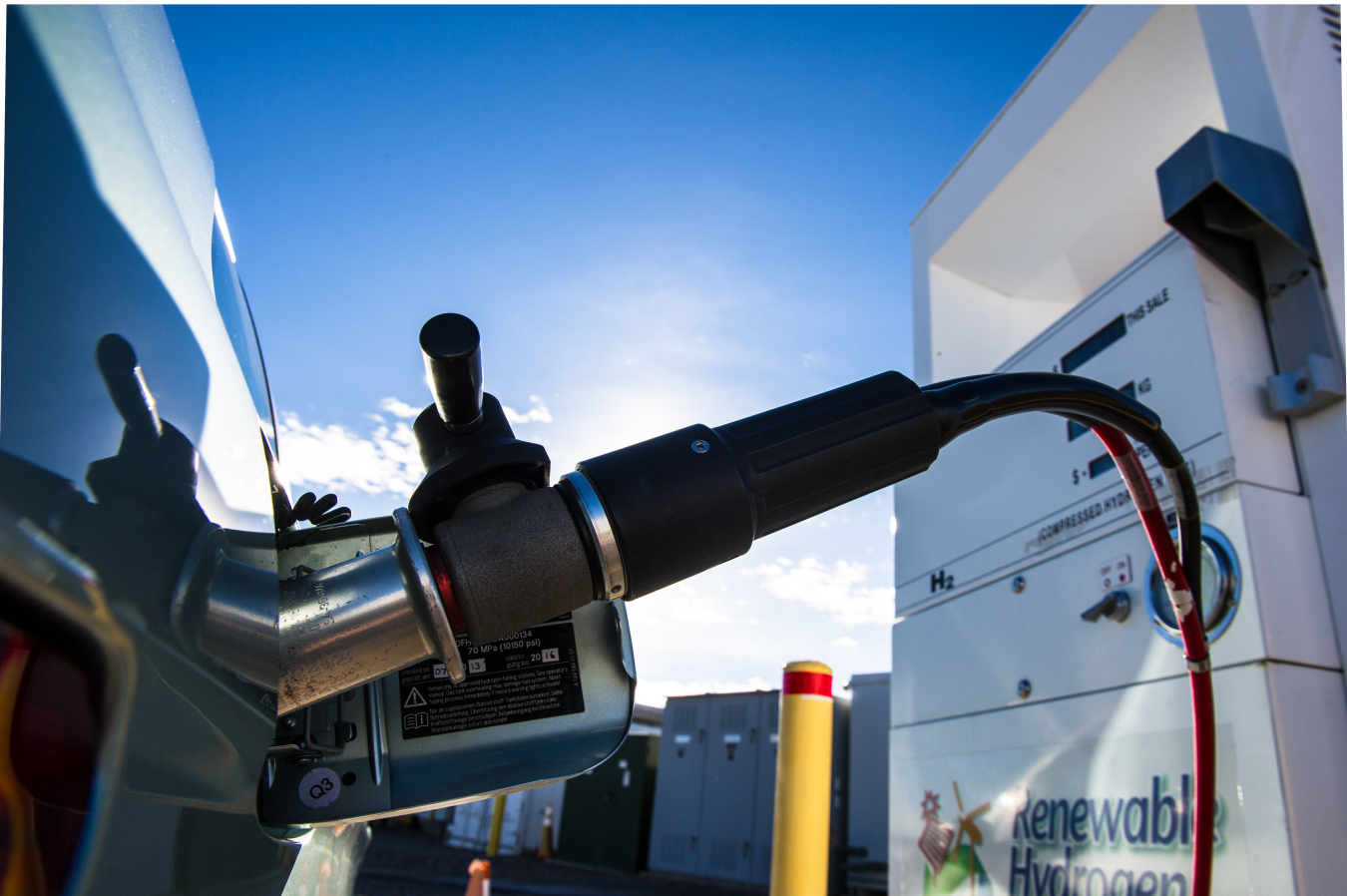The H2 Refuel H-Prize is challenging America’s innovators to develop systems that make it easier and convenient to fuel hydrogen powered vehicles...
Office of Critical Minerals and Energy Innovation
December 29, 2014
A fuel cell electric vehicle is refueled with hydrogen at the National Wind Technology Center in Colorado. The H2 Refuel H-Prize is challenging America’s innovators to develop systems that make it easier and more convenient to fuel hydrogen vehicles. | Photo by Dennis Schroeder, National Renewable Energy Laboratory
Just as charging your electric vehicle at home or place of work is becoming more widely available to the American consumer, what about bringing other fuels to this market? Many gaseous fuels, including propane for your grill and compressed gases at paintball parties, are safe and popular, and millions of homes have natural gas safely and conveniently available for cooking, clothes dryers, fire places, and furnaces.
Even home fueling of your natural gas vehicle is now possible for consumers who can’t easily access a natural gas fueling station. The H2 Refuel H-Prize is challenging America’s innovators to develop systems that make it just as easy to fuel hydrogen powered vehicles, using energy sources delivered to most homes and businesses (electricity and natural gas).
The H-Prize is intended to incentivize researchers and entrepreneurs to think outside the box on topics related to hydrogen. Because hydrogen used in a fuel cell produces only water, electricity and heat, there are absolutely no other emissions and power can be safely and efficiently produced for a huge range of applications ranging from portable power to charge your laptop and cell phone, to large stationary power plants as well as buses, cars, and forklifts.
Fuel cell electric vehicles (FCEVs) are now available for lease in limited regions both in the United States and in other countries and major automakers have announced plans for the commercial sales, whetting the appetite of consumers.
And consumers are interested. FCEVs take only a few minutes to refuel and can travel 300 miles between re-fueling (one FCEV was even validated by DOE to be capable of driving up to 430 miles on a single fill) and they have great performance—with zero emissions from the tailpipe. Even though states like California have plans to build many hydrogen stations or add hydrogen dispensers to existing gasoline stations, this will take time. If early consumers can make their own fuel to refuel their car, they don’t need to worry about the distance to the nearest hydrogen station.
To help connect consumers to hydrogen fuel, the H2 Refuel H-Prize is offering a $1 million prize to the winner of a competition to design and demonstrate small scale systems for on-site hydrogen generation and dispensing that can be used in locations like homes, community centers, or businesses for fueling vehicles. Small scale hydrogen production systems using either water electrolysis or natural gas reforming have been demonstrated before but meeting all the H2 Refuel criteria for fueling, capacity, pressure and cost, to name a few, has still not been demonstrated. Hence the H2 Refuel H-Prize: teams will have two years to design, build, and demonstrate a system that will be independently validated to meet the criteria described in the H2 Refuel H-Prize Final Guidelines Federal Register Notice. The Energy Department is working with the Hydrogen Energy Foundation, which is the administrator of the H-Prize.
Whether you just want to find out what’s happening with the competition, read the full guidelines, or ask questions, visit hydrogenprize.org to learn more. If you’re interested in finding others to team up with, you’ll find a place post your information. If you just want to follow the action, registered teams will be able post information and updates.
Sunita Satyapal

Sunita Satyapal is the Director for the U.S. Department of Energy's (DOE's) Hydrogen and Fuel Cell Technologies Office and coordinates activities across offices for the U.S. DOE Hydrogen Program. She is responsible for more than $1.6 billion in hydrogen and fuel cell research, development, demonstration, and deployment (RDD&D) activities within the office and for coordinating more than $9.5 billion in hydrogen activities across DOE. In addition, she led the development of the national clean hydrogen strategy and roadmap and serves as the Director for the Hydrogen Interagency Taskforce, which includes a dozen agencies and is co-chaired by the Deputy Secretary of Energy and the White House Deputy National Climate Advisor. She has more than two and a half decades of experience across industry, academia, and government, including at United Technologies managing RDD&D and business development, and as a visiting professor.
Sunita also coordinates international hydrogen activities as Vice-Chair of the International Partnership for Hydrogen and Fuel Cells in the Economy, a partnership among over 25 countries to accelerate progress in hydrogen and is the U.S. co-lead for hydrogen efforts within the Clean Energy Ministerial and Mission Innovation. She received her Ph.D. from Columbia University and did postdoctoral work in Applied and Engineering Physics at Cornell University. She has numerous publications, including in Scientific American, 10 patents, and several recognitions including a Meritorious Presidential Rank Award in 2015, a Distinguished Presidential Rank Award in 2022, and selected as an Ambassador for C3E, the Clean Energy Education & Empowerment Initiative, to advance the leadership of women in clean energy.
More by these authors
-
Oak Ridge Institute for Science and Education (ORISE) Postdoctoral Fellow, Fuel Cell Technologies Office


